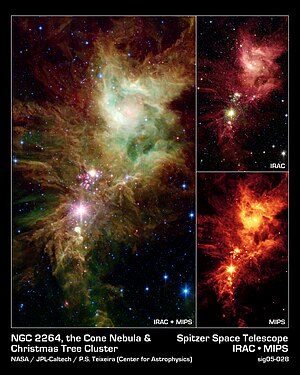Christmas tree star cluster

|
|
| Spitzer - Conenebula in high resolution | |
| AladinLite | |
| Constellation | unicorn |
|
Position equinox : J2000.0 |
|
|---|---|
| Right ascension | 6 h 41.0 m |
| declination | + 09 ° 54.0 ′ |
| Appearance
|
|
| Brightness (visual) | 3.9 likes |
| Physical data | |
| history | |
| Discovered by | Wilhelm Herschel |
| Discovery time | January 18, 1784 |
| Catalog names | |
| OCl 495 • Mel 49 • Cr 112 • Lund 246 • H VIII.5 • Part of NGC 2264 | |
The Christmas tree star cluster is an open star cluster about 2500 light years away in the constellation Unicorn with an apparent magnitude of 3.9 mag.
It owes its name to the fact that in visible light it resembles a Christmas tree . It is a very young and very interesting star formation region by astronomical standards .
The dense gas nebula does not let the light of the young stars ( protostars ) penetrate to the outside, so that we cannot see them. The Spitzer infrared telescope, however, delivers very impressive and, for astronomers, extremely informative images. You can almost see the formation of stars live here. The arrangement of the young stars seems to confirm the theory that their distance depends on the density and temperature of the gas cloud. This snowflake-like structure also gave it the name Snowflake Cluster or Snowflake Nebula.
The pink and red spots in the center of the picture are young stars that are less than a hundred thousand years old. The blue colored points belong to the Milky Way . The green structures are gas clouds mixed with organic molecules , which are excited to glow by neighboring stars.
discovery
Wilhelm Herschel discovered the star cluster on January 18, 1784 and gave it the catalog number H VIII.5.
See also
Individual evidence
Web links
- Spektrum.de : Collection of amateur recordings
